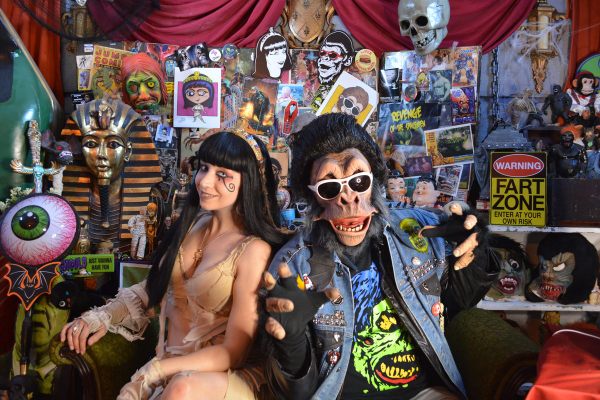How Pollution Spawned a Gang of 1990s Cartoon Villains
Hexxus, Captain Pollution, and the heyday of animated eco-villains.

In the early 90s, cartoon eco-villains were all the rage (20th Century Fox/Jeremy Nyberg/Youtube)

For a short time in the early 1990s, many cartoons gravitated toward a similar sort of villain. Take one part greedy corporate robber baron, add a dash of hatred for the environment, and then garnish with a mutant deformity that mirrors some evil character trait, and you’ve got a recipe for a cartoon eco-villain from the era.
Villains were specifically created to personify the hot button environmental issues of the day. The signature crime of Captain Planet’s Sly Sludge involved illegal dumping of toxic waste, while Hexxus from Ferngully embodied rainforest deforestation. Heroes like the G.I. Joe’s Eco-Warriors used outlandishly eco-friendly measures to combat these evildoers, whether through special backpacks that shot fresh water, or simply the magic of planet Earth, embodied by Captain Planet.
But in the end, it was the villains that said the most about our guilt over polluting the planet, and made it seem like our insurmountable environmental problems could just be socked in the jaw. Even if just for a half hour on a Saturday morning.
The heyday of environmentally-conscious cartoons kicked off in September of 1990 with the premiere of Captain Planet and the Planeteers on TBS. The show followed the adventures of five multi-cultural kids armed with magic rings that could be brought together to summon Captain Planet, a green-skinned avatar of environmentalism. The Planteers faced off against an amazing rogues’ gallery of personified pollutants.
There was Duke Nukem, a radioactive mutant who liked spreading toxic waste, and Sly Sludge, whose M.O. was illegal dumping. Then you had Looten Plunder, a hack-and-slash deforester and poacher, rat-man Verminous Skumm, who embodied the pestilence that thrives in garbage, and fellow evil-doers Dr. Blight, Zarm, and Hoggish Greedly. At one point they came together to form the anti-Captain Planet, called Captain Pollution, a super-villain made of pure filth and pollution.

Dr. Killemoff in The Pollution Solution (Troma/Hulu)
By the next summer, in 1991, another show premiered that had a similar take on eco-friendly themes. Loosely based on the B-movie, The Toxic Avenger, the short-lived cartoon Toxic Crusaders followed a group of deformed misfits as they used their gross-out powers to stop aliens from the planet Smogula (and also, like most all cartoons around this time, to sell toys).
While it peddled a less direct environmental message than Captain Planet, the Toxic Crusaders’ main villain was an eco-villain named Dr. Killemoff. Another alien from the planet Smogula, Killemoff wore a respirator that pumped polluted air into his lungs and belched pollution from large smokestacks on his back. Of course he was also a greedy businessman in charge of a company called Apocalypse Inc.
By the latter half of 1991, long-running cartoons would jump onto the trend as well. In September of 1991, the original Teenage Mutant Ninja Turtles cartoon came out with an episode called, “Muckman Messes Up.” This episode introduced the characters Muckman and Joe Eyeball, a pair of garbagemen that mixed trash with mutagen and became living garbage monsters.
These characters didn’t have a directly pro-environmental message, and would eventually side with the Turtles, but they fell squarely into the trend of creating foils that focused on the issues of pollution and waste.
The next month, the G.I. Joe cartoon would air a two-part episode called “The Sludge Factor.” These episodes introduced the Eco-Warriors, an elite Joe team (featuring characters like Clean Sweep and Ozone) tasked with protecting the environment. Of course the show’s bad guys, called COBRA, had their own evil eco-villain in Cesspool.
Another former CEO, Cesspool originally ran a number of shady refineries and chemical plants that coughed out pollution and toxic waste. However, after he fell into a pool of toxic sludge, getting disfigured in the process, he blamed environmentalists for his accident and joined COBRA as a specialist in pollution.
In 1992, the apex of eco-friendly cartoons came in the form of the theatrical film, Ferngully: The Last Rainforest. The film tells the story of Crysta, a fairy living in an untouched rainforest that is slowly being encroached on by greedy loggers. The lumbermen and their giant machines eventually cut down the wrong tree and release Hexxus, the evil spirit of pollution and environmental decay.
Hexxus, a black cloud of smog, sensually voiced by Tim Curry, begins sucking up all of the oil, grime, and pollution being pumped out by the clear-cutting machinery, gaining power, and celebrating humanity’s willingness to destroy nature. Hexxus’ orgiastic love of pollution is perfectly encapsulated in his spotlight song, Toxic Love, an unreleased version of which actually has the spirit talking about how “horny” it makes him.
It’s hard to top a literal cloud of pollution talking about how environmental destruction turns him on, and alas, the trend of eco-friendly cartoons would never reach that pinnacle again. Captain Planet stayed on the air in some form until 1996, and can still be found in syndication, but in general, the cartoon concern with the environment seems to have been left in the early 1990s.









Follow us on Twitter to get the latest on the world's hidden wonders.
Like us on Facebook to get the latest on the world's hidden wonders.
Follow us on Twitter Like us on Facebook